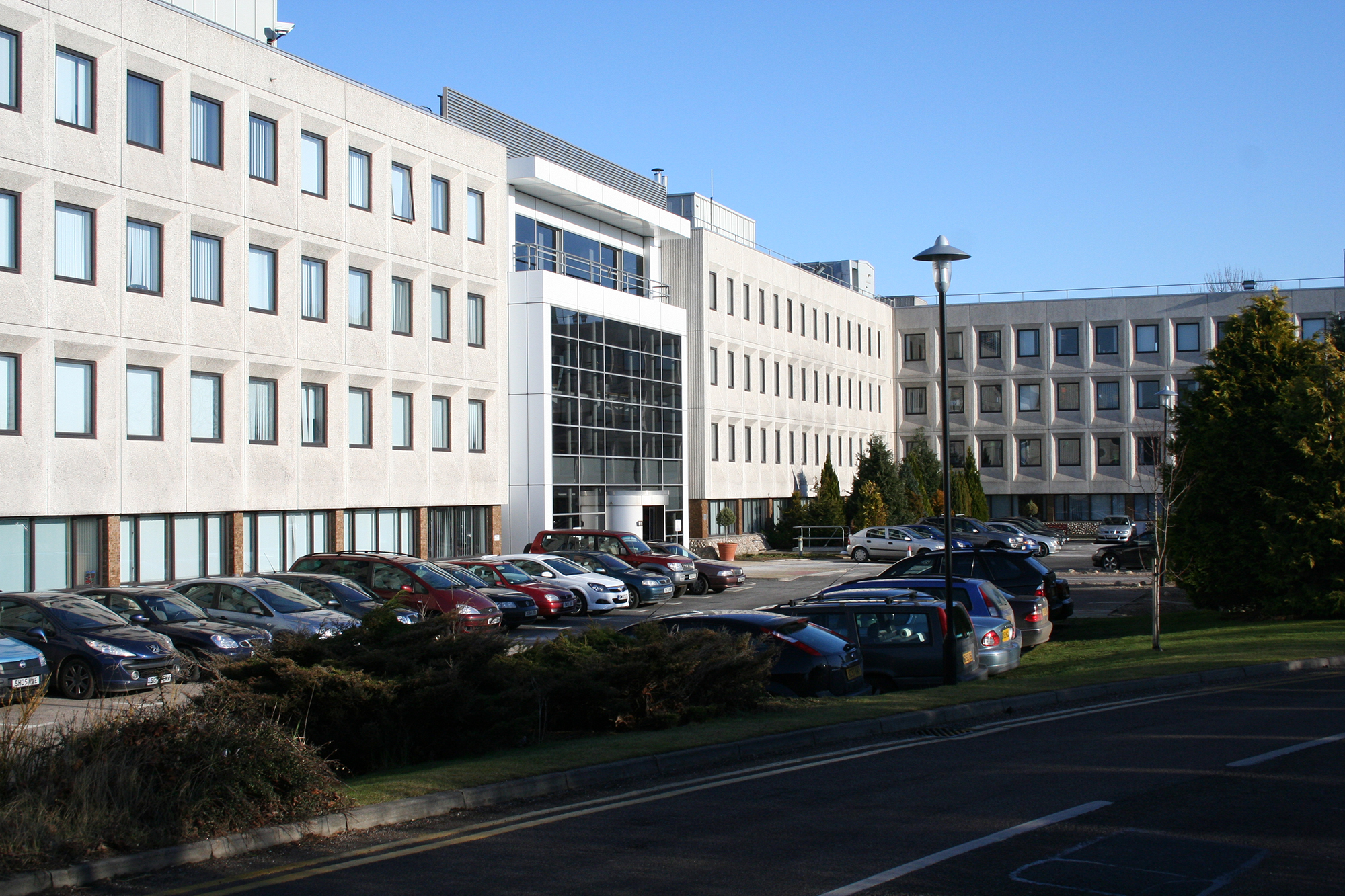by Sandra Duncan, PHOTOGRAPHY BY KEN TAYLOR
Aberdeen, the ‘energy capital of Europe,’ is a port city in northeast Scotland where the rivers Dee and Don meet the North Sea. It is also known as the Granite City because many of its buildings are built from the locally quarried stone, which sparkles in the sun due to its high mica content.

Despite its reputation as a cold, grey city, Aberdeen has traditionally brought a rich and diverse culture to the northeast, and the oil industry has made it one of just three high-productivity hubs in the U.K. The difficult economic climate of the past few years, with its lower commodity prices, inevitably resulted in job losses to an area where one-third of total employment is dependent on oil and gas. Today, 300,000 jobs are still supported by the U.K. oil and gas sector, and more opportunities are slowly reemerging within the industry.
Although the oil and gas sector has experienced monumental changes, the industry continues to produce around half of the U.K.’s oil and gas that would otherwise have been imported. Maintaining a steady fiscal environment in the U.K. is a vital component to ensuring continued investment confidence, and today’s focus has also turned toward maximizing economic recovery (MER), delivering efficiency improvements, building on cost reductions and rationalizing activity. North Sea companies have become more efficient during the downturn, cutting lifting costs by nearly half since 2014 while production overall in the industry has jumped 16 percent.
ConocoPhillips is no stranger to this renewed focus on efficiency. Having operated on the U.K. Continental Shelf for more than 50 years, the company has safely produced oil and gas and consistently delivered value across changing political landscapes and fluctuating economic climates.


Aberdeen, home to ConocoPhillips’ U.K. business unit, is the third most populous city in Scotland, with approximately 200,000 inhabitants. The city’s first inhabitants settled some 8,000 years ago in villages around the mouths of the rivers Dee and Don.
Today, the city has a long, sandy coastline and a climate of chilly summers and mild winters. It is home to two universities — the University of Aberdeen, founded in 1495 in a fortified cathedral, and Robert Gordon University — making it the educational center of northeast Scotland.
The region’s most famous castle is Balmoral, the summer residence of Great Britain’s royal family. Balmoral was purchased in 1848 by Queen Victoria, who described it as “my dear paradise in the Highlands.”
In addition to oil and gas, traditional industries include fishing, papermaking, shipbuilding and textiles. Among Aberdeen’s many distinctions, the city has won the popular Britain in Bloom gardening competition a record-breaking 10 times. In 2015, Aberdeen was named the world’s 57th most livable city, as well as the fourth most livable city in Britain. In 2012, HSBC, a British banking and financial services company, named Aberdeen a leading business hub and one of eight “super cities” spearheading the U.K.’s economy — the only city in Scotland to receive this accolade.
HOME WITH A VIEW
ConocoPhillips U.K.’s main office is Rubislaw House in Aberdeen, located in the city’s west end overlooking the now water-filled 394-foot-wide, 465-foot-deep crater on the site of the old Rubislaw quarry. Europe’s largest man-made hole, the quarry produced more than 6 million tons of grey muscovite biotite granite for some 230 years before its closure in 1971. This stone forms the centerpiece of many of the U.K.’s famous buildings and monuments, including London’s Houses of Parliament and Waterloo Bridge.
Six years before the quarry closed, ConocoPhillips was already operating in the U.K., achieving first flow of gas from the Viking reservoir in the Southern North Sea (SNS) in November 1965. Today, the business includes a variety of offshore assets in the SNS, Central North Sea including J-Area and Britannia, East Irish Sea and West of Shetlands. These range from old platforms, some of which are now being decommissioned, to new discoveries across different construction types that plot their way through time in the history of the oil and gas industry.

Over the decades there have been many new developments and improvements in technology, allowing fields previously deemed uneconomic to be tapped for their reserves. One of the latest additions to the U.K. production figures is the partner-operated Alder high pressure/high temperature (HP/HT) field that ties in to the Britannia facility. With this, the U.K. business is now producing around 6 percent of the company’s overall total production. Thanks to highly detailed planning, further development opportunities have been unlocked at Finlaggan with a third-party subsea tieback to Britannia, and opportunities are being reviewed that could extend the life of the J-Area hub.
Adding to the complexity of numerous fields in a variety of locations in U.K. waters, ConocoPhillips’ onshore support facilities are spread throughout the country. The Europe Commercial team is based in London, with Pensions, Tax and Insurance nearby in Warwick. The Theddlethorpe Gas Terminal is on the east coast of England, and the Rivers Terminal in the northwest. The operations from the Conoco, Phillips and Burlington backgrounds now blend seamlessly to give strength to an organizational mix that is unique to ConocoPhillips U.K.
There is a great diversity across U.K. operations, with infrastructure-led exploration, production, new developments and platforms in the decommissioning and removal phase. There are also wells to drill and complete, wells to plug and abandon, platforms to remove and new third-party business being tied in. In short, the U.K. has ongoing activities throughout the whole of the asset lifecycle.

A CHANGING LANDSCAPE
As some more-mature assets in the U.K. SNS come to the end of their life spans, the business has developed a detailed decommissioning program for plugging and abandoning these assets. “In September, the decommissioning program for Lincolnshire Offshore Gas Gathering System (LOGGS) satellites LDP1 (Vulcan UR/Vampire OD/Viscount VO) went out for public consultation, which is a key milestone in our U.K. decommissioning program,” said Richard Tocher, manager, Decommissioning.


The decommissioning challenge on the U.K. Continental Shelf is significant, with more than 250 subsea production systems and approximately 3,650 wells across the industry, all of which must be decommissioned. In accordance with the U.K. Oil and Gas Authority’s (OGA) principles for MER, there is a need to significantly reduce decommissioning costs through increased efficiency and, more importantly, industry transformations.
Removing the old and looking at innovative ways of implementing the new is altering the landscape across the U.K. business. With this change came the need to update the organization and functions supporting the fields. Three years ago, the U.K. business took the step of changing its operating model to reduce risk, improve efficiency/productivity and reduce cost. An integrated operations (IO) environment was created that encourages collaboration and puts more focus on innovation and technology.


MAXIMIZING NEW TECHNOLOGY
A dedicated Onshore Operating Centre (OOC) forms the heart of IO in Aberdeen. It serves as an inspirational environment delivering sustainable and tangible benefits to the business, including a heightened opportunity for learning and development within a collective, multifaceted team setting. Housing about 15 different functional disciplines supporting the operations in the field, it has enabled new work processes to be implemented with a strong focus on integration and collaboration. After seeing its impact, the well operations team followed suit and opened an Onshore Drilling Centre at Rubislaw House, known as “mission control.”


“The challenge is to continue to maximize the use of new technology to add value to our U.K. North Sea operations as we seek to generate free cash flow. Getting to where we are today has taken significant change throughout the organization. By combining the U.K. offshore and functional teams to achieve results, and embracing the opportunity we had for change at an early stage, costs have been safely reduced and collaboration has increased,” said Brage Sandstad, general manager, Operated Assets.
SAFER TOGETHER
One of the teams at the heart of IO is Health, Safety & Environment (HSE), which has gained efficiency by standardizing and simplifying the way it works by co-location. By reducing bureaucracy, HSE generated opportunities for personnel, strengthened safety processes and improved the sharing of reporting between assets.
“By collaborating and focusing on reducing risk, safety across our operations has taken a step forward, which is reflected in our results as the safest operating business unit within ConocoPhillips.”
“By collaborating and focusing on reducing risk, safety across our operations has taken a step forward, which is reflected in our results as the safest operating business unit within ConocoPhillips,” said Mark Wilson, manager, HSE Performance & Strategy.
Reflecting on a recent milestone of 10 years without a recordable injury in production operations at the Theddlethorpe Gas Terminal, SNS Operations Manager Maurice Thomson said, “For any of our operations to achieve 10 years without a recordable injury is a significant milestone by any standard. This demonstrates individual safety leadership and its contribution to a positive and inspirational safety culture.”

The foundation has been laid to continue the journey to reduce risk across U.K. operations, and the business is now seeing efficiencies that allow more HSE engagement at the planning stage, which in turn proactively reduces risk across the business.
“Finishing 2017 strong and starting 2018 stronger is our safety goal,” said Wilson.” At a recent safety forum, we likened this challenge to the fourth quarter of a 400-meter race, where it is important that we maintain form and concentration and don’t ‘lose it’ at this point. We all have a role to play to ensure our business remains a safety leader. It’s important that we complete our checks, we don’t let complacency creep in, and we are prepared to hold that courageous conversation. Above all, we must never forget that someone’s life might depend on our actions.”

SEAT OF LEARNING
With a program of continuous learning and development, the U.K. business has grown in strength and is successfully delivering ever-improving operational performance at a time when maximizing economic recovery within the U.K. Continental Shelf is vital. This has led to improvements in the quality of decision-making, communication and knowledge sharing and has accelerated learning in a multiskilled environment.
One example is the Southern Wye Project, where ConocoPhillips U.K., ConocoPhillips Norway and partners effectively collaborated to safely disconnect one field and connect another during a maintenance period. This successful teamwork was recognized for its innovative approach, receiving the 2016 Oil and Gas Authority’s MER U.K. Award. The model was highlighted as being transferable across the industry. ConocoPhillips has also been recognized for its role in developing standard industry agreements as well as its leadership role in improving commercial behaviors.

ENSURING ECONOMIC VIABILITY
The U.K. business went through its own efficiency program in 2014-2015, made more vital by the collapse of commodity prices. Ben Tier, manager, Business Strategy explained: “Since 2014 the U.K. has been through three change programs focused on reducing risk and improving efficiency. These changes have paid dividends by attracting investment premised on a competitive cost structure that benchmarks at the top of the U.K. oil and gas industry.”
One such change was the integration of Britannia Operator Limited (BOL) into ConocoPhillips’ operations. From 1998 to 2015, the Britannia gas/condensate field, one of the largest and most significant ever undertaken in the U.K., was operated by BOL, a joint-venture company between ConocoPhillips and Chevron. Much has changed since Britannia’s inception, not least the challenges of a maturing asset in a low price environment and the realities of having to safely maintain a competitive and sustainable cost structure. Integrating BOL into the ConocoPhillips organization streamlined the structure, allowing vital efficiencies to be captured.

SEISMIC HIGH GRADES DATA
2017 was an exciting year for the U.K. as a new drilling campaign started in the J-Area after a two-year break.
“We focused on a complete reevaluation and restack of the opportunity portfolio,” said Chief Geophysicist Mark Brown. “Using state-of-the-art seismic data and advanced geological modelling, reservoir simulation and history matching workflows, we developed a compelling portfolio of drill-ready opportunities.”

In July, the Ensco 120 drilling rig began to work at the Jade platform J10 well. In the fourth quarter, it moved to Jasmine to begin the first well in a two- to three-year program of continuous drilling.
“The campaign will include infill development wells, step-out appraisals and targets in established reservoirs. It will also seek to appraise and further develop the secondary Josephine Sandstone Triassic reservoir, which was found to be surprisingly prolific in the Jasmine S5z well,” Brown said. “The acquisition of new seismic data has been a key factor in high grading the U.K.’s opportunity portfolio. In 2016, we received the fully processed J-Ridge Ocean Bottom Node (OBN) dataset, which gives a high-quality, state-of-the-art 3D dataset across our Judy/Joanne and Jasmine fields. This was acquired using autonomous recording nodes placed directly on the seabed using ropes.”
"Using state-of-the-art seismic data and advanced geological modelling, reservoir simulation and history matching workflows, we developed a compelling portfolio of drill-ready opportunities."

ConocoPhillips was the first operator in the North Sea to use this rope-deployed OBN technology when it acquired the Jasmine survey in 2011. A 2013 Technology Excellence award commended the team for being the first to carry out this innovation. In 2016, the U.K., Alaska and Norway businesses, with the Geophysical Services group in Houston, received a ConocoPhillips SPIRIT of Achievement Award for collaborative development and adoption of the technology.
The technique has now become mainstream and is rapidly becoming an industry standard for ocean-bottom seismic. The same approach was used for the East J-Ridge survey, with a slight twist. “For this, we used ConocoPhillips’ proprietary compressive seismic imaging (CSI) technology to deliver high-quality data at lower cost. This allowed us to use two source boats, shooting simultaneously. The wavefields from the two source arrays were separated by the company’s seismic processing group in Houston, using newly available deblending algorithms. Doubling the source effort allowed a shorter cycle time for acquisition, saving cost without sacrificing data quality,” Brown said.
The improved seismic imaging helps by creating more-accurate maps of the subsurface structure, resulting in better portfolio ranking and decision-making. The data has been very impactful. One previously high-ranked opportunity has been downgraded, while others have been high graded or better defined, and some completely new targets have been added.
LATEST GENERATION POTENTIAL
In addition to the OBN acquisition, the U.K. business recently licensed 70 square kilometers of latest-generation, broadband multiclient streamer data around the Jade field. This data is providing new insights into the fault structure on the eastern flank and has helped firm up understanding of the complex reservoir structure in this area. The data is being used to refresh opinion on the faulting around the Jade South exploration opportunity and around J-Block, which will help identify potential opportunities for future license-round applications.


“Work has not been solely focused on the J-Area, though,” said Andrew Leishman, manager, Subsurface. “The Britannia Satellites team has also been busy developing infill drilling targets at Brodgar and Callanish, which are progressing through internal maturation, quality control and approval processes as drill candidates for the 2019-2020 timeframe.
“Interpretation of the Callanish structure was ambiguous on the old 1995-vintage seismic data,” said Leishman. “So in 2016, we purchased newly reprocessed prestack depth-migrated, multiclient seismic data incorporating improved tomographic velocity modeling and modern deghosting algorithms. This stabilized the reservoir image significantly and reduced uncertainty, resulting in more-robust metrics. Similar data from Brodgar in 2014 has been used to help mature the concept of a Brodgar H4 infill development to the west of existing producers.”
INFRASTRUCTURE NEGOTIATIONS BRING BENEFITS
A large part of the U.K. portfolio is nonoperated, and 2017 was an exceptional year for the ConocoPhillips team in its role as substitute commercial operator (SCO) for the (BP-operated) Clair development. Due to commercial conflicts in the West of Shetland region, ConocoPhillips was authorized by Clair owners to act as SCO.


“We negotiated with infrastructure owners and other field groups to deliver commercial and legal agreements to support Clair operations,” said Commercial Advisor Jenna Harvey.
By delivering a new and reshaped commercial framework for gas processing and hydrogen sulfide removal, the West of Shetland field groups (Clair, Quad and Foinaven) have enabled field investment and provided longevity and security of gas export in addition to preserving West of Shetland value for the U.K.
The Clair asset will reach a significant milestone in 2018 with first production from the Clair Ridge project. Peter Antao, manager, Clair Development, has been seconded to BP to work directly with the Clair Ridge project leadership team. He is seeking to directly affect the work being carried out as they complete drilling and focus on reliability and start-up of Clair Ridge. The commercial team has enabled several agreements to deliver the project.

“We entered into negotiations with infrastructure owners and amended the gas transportation agreements to reflect the changing needs of the Ridge project. This has reduced costs by around $6.5 million,” said Harvey. “We are now negotiating a start-up gas agreement to allow the facilities to be commissioned and a new onshore pipeline to be built that will create a long-term export route for gas to the U.K. market. The first construction and tie-in agreement for this was executed in second quarter 2017. As Clair Ridge will start up before this pipeline is complete, ConocoPhillips, as commercial operator for all Clair fields, is negotiating a short-term gas offtake solution.”
PERFORMANCE DRIVES INVESTMENT
“The last two years have seen significant changes within the business and the operating environment for the U.K. oil and gas industry,” said Terri King, president, U.K. “Commodity prices and political and regulatory issues, including Brexit, have been prominent, but the industry and ConocoPhillips U.K. continue to pursue efficiency improvements and drive change that will have a transformational effect on our operations.

“In a recent 2016 report by Oil and Gas U.K., ConocoPhillips was ranked among the top third for HSE performance against our peers on the U.K. Continental Shelf for reportable injury and hydrocarbon release frequency. Based on 2016 data and 2017 HSE performance for both reportable injuries and hydrocarbon releases, ConocoPhillips is expected to be best-in-class against our peers when the next report is issued. The OGA also assesses ConocoPhillips as the best-in-class operator in the U.K. in terms of unit cost. In addition to being seen as a leader in commercial behaviors with proven and strong delivery, we are continuing to show a tangible increase in cash flow through our performance across the U.K. business.
“Our successes this year include completing the Britannia and J‑Area shutdowns ahead of target, starting the J‑Area drilling campaign, completing stage one of plugging and abandonment at MacCulloch within AFE, and progressing Clair South to approval. We then focused on restarting production at the East Irish Sea with ConocoPhillips personnel seconded to work with the Centrica team at the Rivers Terminal and to safely commission the Clair Ridge drilling and control system, which is on track to complete in the fourth quarter.
“These activities could not have been achieved without the hard work and dedication of the talented teams across the business. They go out of their way to ensure the U.K. remains a positive contributor, safety leader and worthy adversary in the pursuit of investment against competition on a global stage.”











